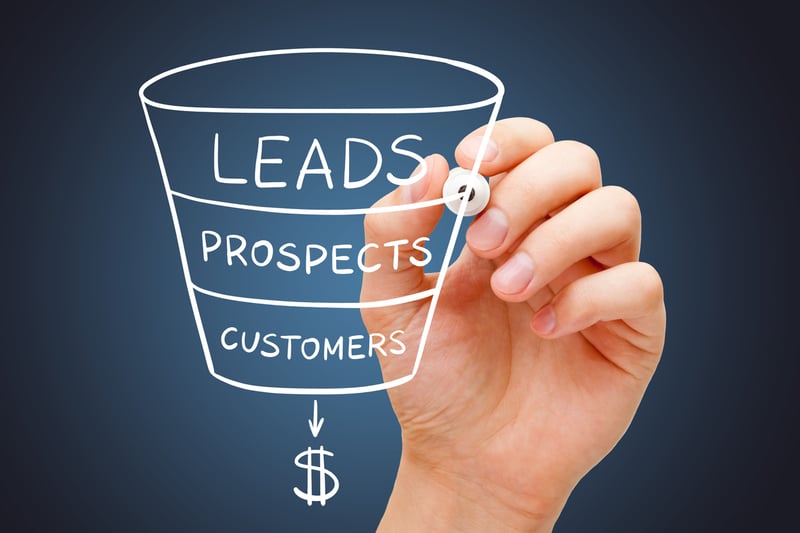
How to Build a B2B Sales Funnel that Guarantees an Excellent ROI
 Updated on
Updated on
By Ringy
Table of Contents
Table of Contents
A B2B sales funnel or pipeline refers to the various stages typical B2B prospects go through during the sales process. The chief goal of a B2B sales funnel is to transform leads into paying customers while increasing ROI is the secondary purpose.
B2B sales funnels are particular for given services or products, but the AIDA (Awareness-Interest-Desire-Action) buyer's journey model forms the basis of its structure.
While it may be enticing to think prospects move linearly through a B2B sales funnel, the reality is very different. Prospects move down and up the sales pipeline either non-linearly or linearly.
Significant B2B sales funnel traffic is required to conduct proper AB testing, meaning prospect and funnel optimization may take longer than expected. If you have the tools and prospect base to test, you should begin doing it immediately and regularly.
This article explores what a b2b sales funnel is, how to create it, the different models and stages, and the challenges involved with building one for your business.
How to Create B2B Sales Funnels
Every business can choose to develop a sales funnel, but only some organizations comprehend how to influence clients to reach the final stages without being too salesy.
An enterprise can have multiple B2B sales funnels for its different marketing channels, including:
- Product funnel
- Social media sales funnel
- Website funnel
- Email funnel
Creating a B2B sales funnel requires that actionable steps are instilled to assist in retaining clients who value your company and products. Here are six steps to focus on when building your B2B sales funnel.
Decide Who the Sale Funnel Is For
Narrowing your focus on a specific demographic or target audience significantly increases prospect conversion rates. This streamlines the sales funnel’s development by asking questions about your customer's present circumstances, their interests, or how they look.
One of the biggest mistakes business owners make is creating B2B sales funnels that are too inclusive in breadth.
Gather the Skills and Team Required
Creating a sales funnel is no easy feat. The activities at the top of the sales funnel range in difficulty and need different skills than the opposite end. It is crucial to have a specialized team, as no single employee can handle all these tasks efficiently.
Finding the right people to concentrate on each step of the sales process in B2B sales funnels is the best way to achieve results. Project managers or sales specialists should be recruited to address the concerns of new or existing clients. This is especially important if your sales funnel dilates beyond the buying step.
Perform In-Depth Research
Conducting research assists in locating hiccups in your B2B sales strategy that you may miss due to enthusiasm. It gives business owners the ability to predict prospect behavior while understanding the current state of the market.
Research shows you how to guide the potential buyer down the B2B sales funnel, giving you a better chance of converting the prospect into a paying customer. It helps to create a flowchart that displays the sub-steps and specific phases the client goes through in the pipeline.
Utilize Your Marketing Department
Marketing and sales teams should collaborate for the common good of an organization.
However, this is only sometimes the case!
Omnipresent internet connectivity has increased the digitization of the purchaser's journey. Over 70% of B2B clients perform independent research before investing their money into a product or service. Previously, the aim was to close the deal, but now the mindset has shifted to providing more informational benefits.
Sales and marketing teams must work together to give customers a service or product that offers the solution they require and positively impacts them. This not only boosts business revenue but also increases customer satisfaction levels.
Launch the Sales Funnel

Once your B2B sales funnel is live, you can compare results and testing stages. This involves monitoring landing page visits, and the number of CTA clicks your product receives. By constantly testing, sales teams can view all prospect activity and make adjustments where required, so they don't lose a client.
Never attempt to augment and repair a B2B sales funnel simultaneously; instead, concentrate on case studies and tools to determine if your strategy is working.
Calculate Conversion Rates
Constantly improving is the way companies thrive within their respective industries. Help your potential client choose you over other businesses by only showing them relevant information about your organization. Valuable information, such as the number of customers at each step of the pipeline and their preferences, can be delineated by analyzing your B2B sales funnel.
Once you have the data, use key indicators to help monitor the prospect's progression through the funnel and your team’s progress. Determine where your team shines and look for opportunities or areas that could be improved.
B2B Sales Funnel Examples

What would a B2B sales funnel article be without some examples of the different types of models companies implement? Here we look at the basics behind each method so you'll have a better idea of how they work.
The AIDA Model
The four-stage AIDA model utilizes these attributes to move the client through the B2B sales pipeline:
- Attention
- Interest
- Desire
- Action
During interactions with each phase, content generally attracts prospects' attention to your brand, builds interest in your service or product, stimulates a desire for it, and promotes actions to test or purchase it.
The Forrester Model
Forrester developed the 5Is marketing model to help businesses structure their outreach efforts.
The 5Is stand for the level of:
- Involvement
- Interaction
- Intimacy
- Influence
- Impact
These engagement actions are based on the prospects' interactions with a brand over a specific period. Metrics for the 5Is are measured via web analytics, customer interactions, qualitative client feedback, market sentiment, and more.
McKinsey's Loyalty Loop
Mckinsey's Loyalty Loop recognizes that once a client buys a product, they rethink whether purchasing the item was the correct thing to do if they would recommend it to friends or family, and wonder if they would repurchase the same item.
This method involves looking at the customer journey through six stages. The loyalty loop shows how prospects decide what they want to buy and whether they wish to stay with their choice. Here are the six phases to examine during the customer journey:
- Consider - The prospect considers options that fit their requirements
- Evaluate - The potential customer determines which is the best product or service for their needs
- Buy - Purchasing of a specific product or service
- Enjoy - During this phase, several situations can occur, but they're all based on the customer’s enjoyment
- Advocate - The customer turns into a brand advocate and recommends a company's products or services
- Bond - The client trusts the brand and has formed a strong bond with the organization.
Using these stages to track a client's journey in and out of business is an excellent way to gather invaluable insights into customer behavior. Mckingsley's Loyalty Loop is a system that promises to show a lot of positive results because it focuses on the customer first.
Heinz Marketing's Bowtie
The Heinz Marketing Bowtie stretches past conventional B2B sales funnels by including both customer advocacy and loyalty phases. Customers are captivated by the brand due to its concentration on building trust, strengthening its reputation, and maintaining long-term relations with its clients.
This strategy allows marketers to monitor revenue-impacting factors and track customer growth rates. Utilizing the Heinz Marketing Bowtie strategy, you can follow these metrics:
- Churn rate
- Retention rate
- Customer lifetime value
- Pipeline data for repeat customers and referrals
- Renewal rate
Besides the above insights, this strategy creates a competitive advantage because it's focused on keeping the clients satisfied and ardent after the sale.
The Conversion Funnel
The primary task of The Conversion Funnel is to generate sales. These strategies monitor the customer journey from awareness to conversion, which could mean signing up for a monthly email, completing a form, or purchasing a product.
Conversion funnels are the cornerstone of all e-Commerce business models, influencing prospects as soon as they notice a brand to the second they buy a product from it. Most e-Commerce conversion funnels utilize the AIDA model while using marketing triggers during stages to reach out to customers.
JB Media Group's Sales Funnel
The JB Media Group promotes a sales funnel built around four stages in the customer journey.
The table below showcases each phase with an example of what to do during each one:
|
JB Media Group Sales Funnel Stage |
Actionable Steps |
|
Awareness stage |
Offer prospects educational information to grow their awareness of a solution. |
|
Consideration stage |
Help the customer understand the product better by including buyer’s guides, videos, case studies, and more on your website |
|
Decision stage |
Once the customer is ready to purchase a product, you could offer them a free consultation, trial, or demo to bring them closer to sealing the deal |
|
Retention stage |
Continue to provide the customer with valuable information about the service or product sold. Increase customer lifetime value by nurturing clients after sales. |
RAIN Group's Buying Process
The RAIN Group's Buying Process utilizes questioning techniques to unravel in-depth information concerning the buyer's requirements and desires. Sales representatives sell perspectives, insights, and ideas that impact the purchaser's decision-making. With a complete understanding of the target market, salespeople can close more deals while overcoming hurdles in concluding a sale.
The following elements are included in the Rain Group's Buying Process:
- Understanding how to approach different buyer personas
- Influencing the buyer's agenda
- Building trust, rapport, and relationships with potential buyers
- Determining and articulating the value of your business's products or services
- Inspiring the prospect to take action
These areas are the most important to concentrate on when achieving success with this strategy.
Stages of a B2B Sales Funnel

B2B sales representatives need to be more systematic and strategic than business to consumer (B2C) organizations when approaching customers. Knowing the right moment to pitch a client or what to talk about next is vital to the outreach effort.
Understanding that the customer journey isn't a straight line can help you determine where they are in the B2B sales funnel. Follow these six stages of a B2B sales funnel to know where your prospects are.
Awareness
This phase involves creating awareness around your product or services through various inbound marketing channels, such as TikTok videos or blog posts. Sales and marketing teams promote the brand, share solutions or advice to common client issues, and collect leads.
Interest
During this stage, you need to concentrate on building the buyer-brand relationship through informative content. This could also involve retargeting prospects with a blog post or article explaining how your solution can help their problem.
Consideration
At this stage, prospects are considered qualified and think your solution can assist them. This is when sales and marketing efforts focus on the product or service. Case studies, free trials, and email marketing campaigns are excellent instruments to move the buyer along during this phase.
Intent
Intent shows the buyer's possible interest in your brand or product because it demonstrates buying signals, such as responding to an email or booking a demo. These buyers need to decide which solution to go with, so include product-focused videos or whitepapers in your marketing collateral that can support demonstration conversions or sales activity qualifications.
Evaluation
When the final buying decision occurs, the evaluation stage commences. Now that the people have researched and weighed up their options, it's time for them to choose a solution.
Sales teams should leverage urgency in their pitches to get the customer to sign off the deal faster. You can also discuss service level agreements, discounts, or other negotiable points here.
Purchase
Finally, the customer has purchased the product or service and has become your client. Now comes the most critical part, building a relationship so that retention rates improve and customer satisfaction levels increase.
Challenges When Building a Sales Funnel for B2B
Each phase of the sales funnel correlates with the customer’s journey as they move through it. As you already know, the client journey is more nuanced than it appears. Here are some of the most prominent challenges marketers face when building sales funnels for B2B.
Standing Out From Competitors
The plethora of competitors out there makes B2B selling incredibly challenging. Irrespective of how engaging your marketing efforts are, prospects may still purchase from another vendor. Moreover, customer journey touchpoints are becoming more diverse, making the procedure relativity taxing.
Creating Compelling Content
Content creation is the driving force behind better ROIs in the B2B landscape. Whether you cater to a broader client base or niche network, the correct content can alleviate your sales funnel difficulties.
With the massive selection of online information, it takes time to guarantee the desired returns from your content.
Generating Too Many Leads
According to HubSpot, over 60% of marketers need help generating leads and traffic for their B2B sales funnels. The abundance of competing businesses makes it arduous to extract more leads from the market each new year.
Marketers must think of clever ways to generate qualified leads through various inbound marketing practices. Without innovation and informative content creation, more leads will choose competitors instead of you.
Conclusion

B2B sales funnels are integral to any online or e-Commerce business model. Whether managing the customer through their journey or monitoring behavior insights with your sales team, B2B sales funnels provide a wealth of information.
Combining your B2B sales funnel with a CRM platform is a great way to achieve results. A CRM solution like Ringy is perfect for storing and tracking customer data while keeping sales teams on top of outreach efforts.
Request a demo to see how Ringy has been helping organizations in the insurance, remote sales, finance, and recruiting sectors boost overall business productivity and sales.

Skyrocket your sales with the CRM that does it all.
Calling? Check. SMS? Check. Automation and AI? Check. Effortlessly keep in touch with your customers and boost your revenue without limits.

Take your sales to new heights with Ringy.
Sales in a slump? Ringy gives you the tools and flexibility you need to capture leads, engage with them, and turn them into customers.
Subscribe to Our Blog
Enter your email to get the latest updates sent straight to your inbox!
Categories
Related Articles




































































































